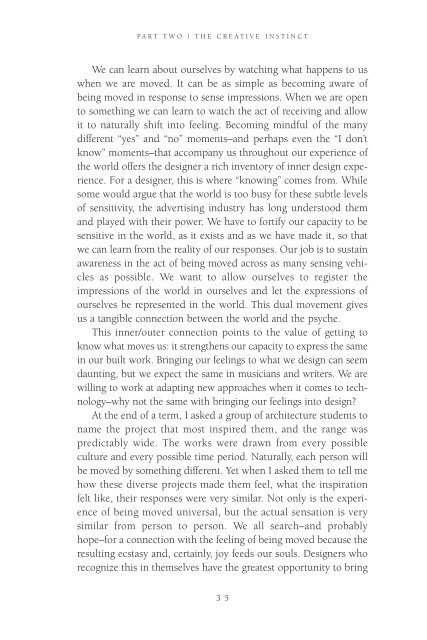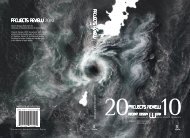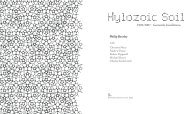The Inner Studio - Riverside Architectural Press
The Inner Studio - Riverside Architectural Press
The Inner Studio - Riverside Architectural Press
You also want an ePaper? Increase the reach of your titles
YUMPU automatically turns print PDFs into web optimized ePapers that Google loves.
PART TWO | THE CREATIVE INSTINCT<br />
We can learn about ourselves by watching what happens to us<br />
when we are moved. It can be as simple as becoming aware of<br />
being moved in response to sense impressions. When we are open<br />
to something we can learn to watch the act of receiving and allow<br />
it to naturally shift into feeling. Becoming mindful of the many<br />
different “yes” and “no” moments–and perhaps even the “I don’t<br />
know” moments–that accompany us throughout our experience of<br />
the world offers the designer a rich inventory of inner design experience.<br />
For a designer, this is where “knowing” comes from. While<br />
some would argue that the world is too busy for these subtle levels<br />
of sensitivity, the advertising industry has long understood them<br />
and played with their power. We have to fortify our capacity to be<br />
sensitive in the world, as it exists and as we have made it, so that<br />
we can learn from the reality of our responses. Our job is to sustain<br />
awareness in the act of being moved across as many sensing vehicles<br />
as possible. We want to allow ourselves to register the<br />
impressions of the world in ourselves and let the expressions of<br />
ourselves be represented in the world. This dual movement gives<br />
us a tangible connection between the world and the psyche.<br />
This inner/outer connection points to the value of getting to<br />
know what moves us: it strengthens our capacity to express the same<br />
in our built work. Bringing our feelings to what we design can seem<br />
daunting, but we expect the same in musicians and writers. We are<br />
willing to work at adapting new approaches when it comes to technology–why<br />
not the same with bringing our feelings into design?<br />
At the end of a term, I asked a group of architecture students to<br />
name the project that most inspired them, and the range was<br />
predictably wide. <strong>The</strong> works were drawn from every possible<br />
culture and every possible time period. Naturally, each person will<br />
be moved by something different. Yet when I asked them to tell me<br />
how these diverse projects made them feel, what the inspiration<br />
felt like, their responses were very similar. Not only is the experience<br />
of being moved universal, but the actual sensation is very<br />
similar from person to person. We all search–and probably<br />
hope–for a connection with the feeling of being moved because the<br />
resulting ecstasy and, certainly, joy feeds our souls. Designers who<br />
recognize this in themselves have the greatest opportunity to bring<br />
35





